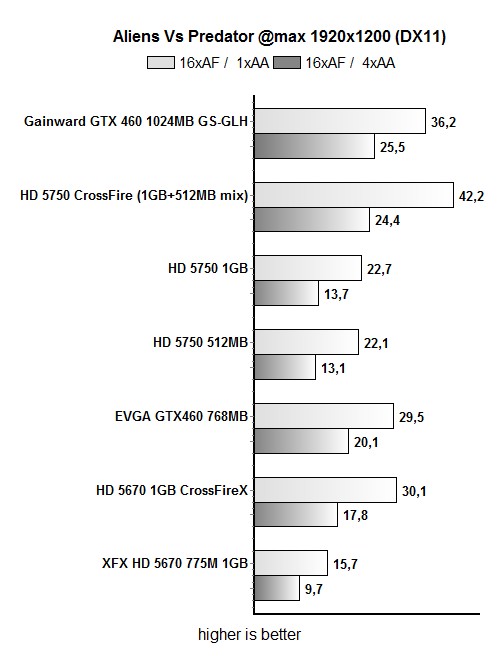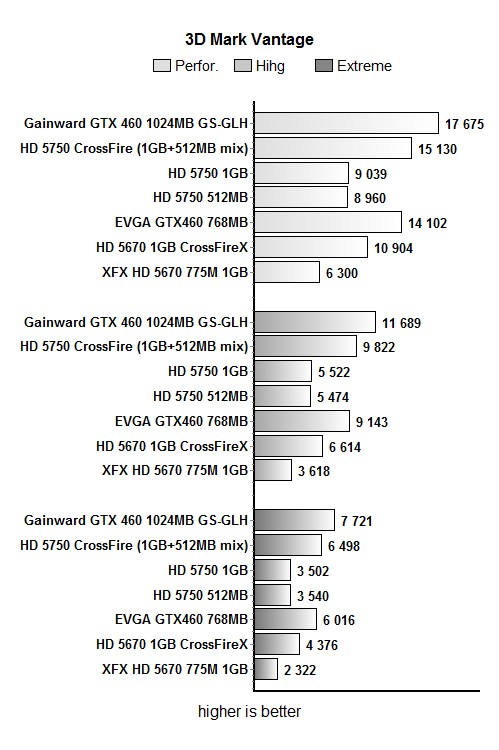Index


Review: CrossFire makes sense in mainstream
While reviewing XFX's HD 5670, we decided to run some CrossFire tests and compare them to Nvidia's GTX 460, the latest DirectX 11 graphics card to appear on the market. Obviously, this is a rather strange comparison, but as the GTX 460 768MB costs twice as much as a single HD 5670, we thought it would be a nice idea to see how the addition of a second card in CrossFire could improve performance. So far the results have been rather good and it's obvious that upgrading your rig with a second entry level card can boost performance quite a bit. Obviously, you won’t have to spend a fortune on such an upgrade, but most users still stick to single card setups. We can only guess that CrossFire and SLI are associated with high-end cards and enthusiasts who like to squeeze everything they can from their gaming rigs. Our review clearly proves that CrossFire makes quite a bit of sense in the value market as well, provided you have a CrossFire capable motherboard, of course. Most motherboards nowadays are CrossFire capable, so this should not be a major issue.
However, several of our readers believe that the comparison was not very realistic, as few consumers would choose to use two HD 5670 cards in CrossFire. Well, that was the point, few will actually do so, but why? The first part of the review clearly proved that two dirt cheap cards can easily match a card that costs twice as much, so it’s obvious CrossFire should not be reserved for high-end cards. It makes perfect sense in the mainstream segment, as it offers a viable upgrade option and quite a bit more flexibility.
Therefore we chose to do another review, but this time we pitted two HD 5750 cards with 512MB of memory against a single GTX 460 1GB card. In this case we used Gainward’s non-reference GTX 460 GS-GHL card, but the cost breakdown remains similar to our previous test. It costs about more than twice as much as a reference HD 5750 512MB. There is also a somewhat controversial issue with the Gainward card. We’re not sure whether all retail models will feature a heatsink on their power components, which could limit overclocking, but that is irrelevant in today’s test.
Testbed:
Gainward GTX 460 Golden Sample Goes Like Hell 1GB
HD 5750 512MB
HD 5750 1GB
EVGA GTX 460 768MB (675MHz/3600)
XFX HD 5670 775M 1GB
Sapphire HD 5670 1GB
Motherboard: EVGA 4xSLI
CPU: Core i7 965 XE (Intel EIST and Vdrop enabled)
Memory: 6GB Corsair Dominator 12800 7-7-7-24
Harddisk: OCZ Vertex 2 100 GB
Power Supply: CoolerMaster Silent Pro Gold 800W
Case: CoolerMaster HAF X
Fan Controler: Kaze Master Pro 5.25"
Operating System: Win7 64-bit
258.80_desktop_win7_winvista_64bit_english
10.6 CCC
In AvP, the Radeons clearly have an upper hand, although the GTX 460 manages to win back some ground with 4x AA.
In Dirt 2, the Radeons can’t keep up with the GTX 460 OC, but they don’t fall too far behind, either.




However, when it comes down to value for money, two HD 5750 cards look like a much better deal than a factory overclocked Gainward GTX 460 GS-GLH. In fact, two HD 5750s will set you back around €200, while the overclocked GTX 460 costs some 15% more. On the other hand, the cheapest reference GTX 460 cards are available for around €180, but they would not be able to match the GS-GHL card in terms of performance as it is clocked at 800MHz, or some 18 percent over the reference clock.
While it might seem like an odd comparison, it proves an interesting point. In some scenarios you are better off with two cheaper cards rather than a single pricey card. In fact, this fact could work against Nvidia, as the GTX 460 has made the GTX 480 quite pointless for gamers. Two GTX 460 cards cost quite a bit less than a GTX 480, yet they deliver more performance. Two mainstream cards in CrossFireX make sense for users on a budget, as they will be able to easily upgrade if there is need for more performance at some point. It’s worth noting that graphics card prices tend to tumble as soon as new architectures are introduced, so bargain hunters could wait for a few months and score a second card at ridiculously low prices.
Both ATI and Nvidia have managed to vastly improve scaling in multi-GPU configurations, and they are becoming more tempting with every driver update.

